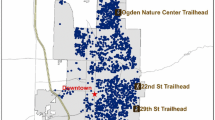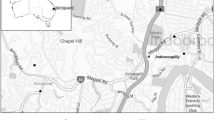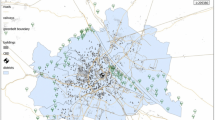Abstract
This is the first study to use an hedonic spatial autoregressive model to assess the impact of wireless communication towers on the value of residential properties. Using quantile analyses based on minimum distances between sold properties and visible and non-visible towers, we examine the relationship between property values and wireless tower proximity and visibility within various specified radii for homes sold after tower construction. For properties located within 0.72 kilometers of the closest tower, results reveal significant social welfare costs with values declining 2.46% on average, and up to 9.78% for homes within tower visibility range compared to homes outside tower visibility range; in aggregate, properties within the 0.72-kilometer band lose over $24 million dollars.


Similar content being viewed by others
Notes
Wireless devices include special feature phones, smartphones, and tablets.
CTIA defines a cell site as the location of wireless antenna and network communications equipment necessary to provide wireless service in a geographic area (CTIA 2015).
In their paper, the authors refer to wireless towers as cellular phone base stations.
Sold properties data draw from the Gulf Coast Multiple Listing Service, Inc., a wholly owned subsidiary of the Mobile Area Association of Realtors, Inc.
These data draw from the U.S. Federal Communication Commission’s Antenna Structure Registration database, available at http://wireless.fcc.gov/antenna/index.htm?job=home.
These data draw from the U.S. Census Bureau, available at http://www.census.gov.
The Viewshed tool is available as part ESRI ArcGIS® software package.
Digital elevation maps draw from publicly available information hosted by the Geospatial Data Gateway of the U.S. Department of Agriculture’s Natural Resources Conservation Service.
An anonymous referee observed that every property within a 1 km radius of a tower is also within the towers’ viewshed. We believe that this unusual result is consistent with the average height of a wireless tower in our dataset of approximately 60 m, and, more importantly, with the fact that our property sales data draw from a fairly flat coastal geographical area (i.e., the average housing elevation of our sample ≈ 11 m above sea level).
There is a quadratic relationship between the logarithm of the property price and the number of bedrooms. We evaluate the semi-elasticities at the mean values of the number of bedrooms as reported in Table 2.
This figure was calculated using equation (4). Let \( {\widehat{\boldsymbol{y}}}_1 \) be a column vector (5828 × 1) of predicted housing prices obtained by evaluating exp(Xβ) at the average values of all of the price predictors with D = 1 (sold after tower construction) and \( {\widehat{\boldsymbol{y}}}_0 \) the predicted housing prices counterpart with D = 0 (sold before tower construction). We define the change in welfare of each household i within Sample 1, as the element-by-element subtraction ΔW i = \( {\widehat{y}}_{1 i} \) - \( {\widehat{y}}_{0 i} \). Finally, the aggregate welfare impact was obtained by taking the sum of the elements of the column vector ΔW, i.e., \( {\sum}_{i=1}^{5,828}\varDelta {W}_i=-24,081,385 \).
We calculate a 10% increase in the average minimum distance for houses in Sample 1 as 0.49 km ∙ 0.1 ≈ 50 m. A 0.59% increase in the average housing price of Sample 1 is $163,008.8 ∙ 0.0059 ≈ $ 961.80.
The U.S. Census Bureau list of metropolitan statistical areas ranks Mobile County, Alabama at number 127. Data available at http://factfinder.census.gov/faces/tableservices/jsf/pages/productview.xhtml?src=bkmk.
The Port of Mobile is home to the twelfth busiest port in the U.S., and ninth busiest port along the Gulf Coast, ranked by cargo tonnage handled as reported by the U.S. Department of Transportation, available at http://www.rita.dot.gov/bts/sites/rita.dot.gov.bts/files/publications/national_transportation_statistics/html/table_01_57.html.
References
Airwave Management, LLC (2013). Cell tower lease rates exposed. http://www.cell-tower-leases.com/Cell-Tower-Lease-Rates.html. Accessed 6 March 2016.
Anselin, L. (1988). Spatial econometrics: methods and models. Dordrecht: Kluwer Academic Publisher.
Anselin, L., Bera, A. K., Florax, R., & Yoon, M. J. (1996). Simple diagnostic tests for spatial dependence. Regional Science and Urban Economics, 26(1), 77–104.
Bond, S. (2007a). Cell phone tower proximity impacts on house prices: a New Zealand case study. Pacific Rim Property Research Journal, 13(1), 63–91.
Bond, S. (2007b). The Effect of Distance to Cell Phone Towers on House Prices in Florida. The Appraisal Journal, 75(4), 362–370.
Bond, S., & Beamish, K. (2005). Cellular phone towers: perceived impact on residents and property values. Pacific Rim Property Research Journal, 11(2), 158–177.
Bond, S., & Wang, K. K. (2005). The impact of cell phone towers on house prices in residential neighborhoods. The Appraisal Journal, 73(3), 256–262.
Bowes, D. R., & Ihlanfeldt, K. R. (2001). Identifying the impacts of rail transit stations on residential property values. Journal of Urban Economics, 50(1), 1–25.
Caudill, S. B., Affuso, E., & Yang, M. (2014). Registered sex offenders and house prices: an hedonic analysis. Urban Studies, 52(13), 2425–2440.
Centers for Disease Control and Prevention (2015) CDC data predicts death of landline home phones. http://siliconangle.com/blog/2015/02/25/cdc-data-predicts-death-of-landline-home-phones. Accessed 5 March 2016.
Cisco (2013). VNI mobile forecast highlights, 2013–2018, United States – 2013 Year in Review. http://cisco.com/assets/sol/sp/vni/forecast_highlights_mobile. Accessed 2 March 2016.
CTIA - The Wireless Association® (2015). Annual Wireless Industry Survey. http://ctia.org/your-wireless-life/how-wireless-works/annual-wireless-industry-survey. Accessed 6 Feb 2017.
Entner, R. (2012). The Wireless Industry: The Essential Engine of U.S. Economic Growth. Recon Analytics, May, 30–33.
Federal Communications Commission (1996). Telecommunications Act of 1996. https://transition.fcc.gov/telecom.html. Accessed 10 April 2016.
Filippova, O., & Rehm, M. (2011). The impact of proximity to cell phone towers on residential property values. International Journal of Housing Markets and Analysis, 4(3), 244–267.
Florax, R. J., & De Graaff, T. (2004). The performance of diagnostic tests for spatial dependence in linear regression models: a meta-analysis of simulation studies (pp. 29–65). Berlin-Heidelberg: Advances in Spatial Econometrics, Springer.
Grass, R. G. (1992). The estimation of residential property values around Transit Station sites in Washington, D.C. Journal of Economics and Finance, 16(2), 139–146.
Jensen, C. U., Panduro, T. E., & Lundhede, T. H. (2014). The vindication of don Quixote: the impact of noise and visual pollution from wind turbines. Land Economics, 90(4), 668–682.
LeSage, J., & Pace, R. K. (2009). Introduction to spatial econometrics. Boca Raton: CRC Press.
Locke, S. L., & Blomquist, G. C. (2016). The cost of convenience: estimating the impact of communication antennas on residential property values. Land Economics, 92(1), 131–147.
Mahan, B. L., Polasky, S., & Adams, R. M. (2000). Valuing urban wetlands: a property price approach. Land Economics, 76(1), 100–113.
Martin, S. L. (1997). Communications tower Sitings: the telecommunications act of 1996 and the battle for community control. Berkeley Technology Law Journal, 12(2), 483–501.
McDonough, C. C. (2003). The impact of wireless towers on residential property values. Assessment Journal, 10(3), 25–32.
Nelson, A.C., & McCleskey, S.J. (1990). Improving the effects of elevated transit stations on neighborhoods. Transportation Research Record (1266), 173–180.
Paterson, R. W., & Boyle, K. J. (2002). Out of sight, out of mind? Using GIS to incorporate visibility in hedonic property value models. Land Economics, 78(3), 417–425.
Pearce, A.P., Carlson, J.R. & Pagano, M. (2013). Wireless broadband infrastructure: catalyst for GDP and job growth 2013-2017. http://apps.fcc.gov/ecfs/document/view?id=7520949630. Accessed 6 March 2016.
Rosen, S. (1974). Hedonic prices and implicit markets: product differentiation in pure competition. Journal of Political Economy, 82(1), 34–55.
Summers, L. (2010). Technological opportunities, job creation, and economic growth. Remarks at the New America Foundation, June 29, 2010. http://larrysummers.com/wpcontent/uploads/2015/07/Technological-Opportunities_6.28.2010.pdf. Accessed 4 March 2016.
Tobler, W. R. (1970). A computer movie simulating urban growth in the Detroit region. Economic Geography, 46, 234–240.
United Nations, International Communication Union (2015). ICT Facts and Figures. http://www.itu.int/en/ITU-D/Statistics/Pages/facts/default.aspx. Accessed 11 April 2016.
Author information
Authors and Affiliations
Corresponding author
Rights and permissions
About this article
Cite this article
Affuso, E., Reid Cummings, J. & Le, H. Wireless Towers and Home Values: An Alternative Valuation Approach Using a Spatial Econometric Analysis. J Real Estate Finan Econ 56, 653–676 (2018). https://doi.org/10.1007/s11146-017-9600-9
Published:
Issue Date:
DOI: https://doi.org/10.1007/s11146-017-9600-9




